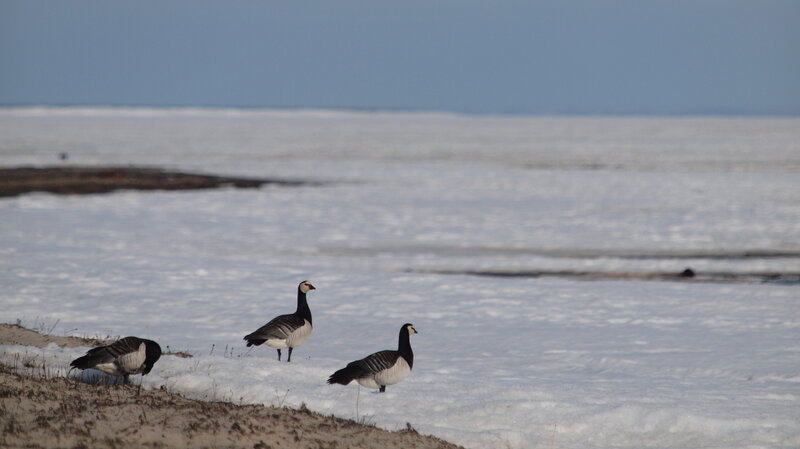 |
| A group of barnacle geese |
There are several different species of migrating birds in the world and all of them carry out their epic seasonal journeys in various corners of the world. Each species has its own flight pattern; the most common pattern involves flying north in the spring to breed during the summer in the Arctic Circle and returning in the fall to wintering grounds in the southern regions. One such bird that conducts this kind of migratory pattern is the barnacle goose. Every spring, barnacle geese make an epic 1,800-mile long journey from northern Germany and the Netherlands to their breeding grounds in parts of Russia above the Arctic Circle. According to Dr. Bart Nolet of the University of Amsterdam and the Netherlands Institute of Ecology, the journey normally takes about a month and the birds make several stops to eat and fatten up laying their eggs. However, that migration pattern is changing due to dramatic rise in temperatures which have contributed to early springs in the Arctic. Dr. Nolet's team tracked several geese to understand how they are being affected by the earlier snow melts. Their results were published in a study in Current Biology. The one thing that has not changed is what time of year the birds start flying south. Dr. Nolet stated that they leave their wintering grounds "around the same date regardless of whether it's early or late spring in the Arctic." It is possibly because the geese "cannot predict what the weather is or what the season is up there from 3,000 kilometers distance."
 |
| Migration route of barnacle geese with wintering grounds (blue), stopover sites (yellow and diagonal grid), and breeding grounds (red). |
The geese historically used to arrive just after the melting of snow and lay their eggs right away. This gives plants time to grow so that the goslings can benefit from what is known as a "food peak." But lately, the weather in parts of the birds' migratory route in the north is warmer than it used to be making them realize they are running late and are therefore forced to speed up. This month-long journey has been reduced to a week-long migratory marathon with geese flying almost non-stop from their wintering grounds to breeding grounds. Although the geese make up time on the way, they could not lay their eggs right away because they need time to rebound and forage which could take some ten more days. Dr. Nolet says that means the goslings are unable to enjoy the "food peak." That is, once the eggs hatch, the food is already degenerating in quality, and what Dr. Nolet and his team found was that goslings "survive less well in such an early ear than they do normally." He further added that the reason the geese do not set off earlier for their northbound journey is because they probably take their cue to depart based on how long daytime hours last, instead of the temperature some 1,800 miles away. Fortunately, the barnacle goose is a "flexible" species that flies in groups, meaning when few start departing early, others would follow.
.jpg/1920px-Branta_leucopsis_EM1A2624_(27349357341).jpg) |
| Barnacle goose family in Sweden |
I find this to be a clear indication of how climate change can have a profound impact on wild animals and why it should be taken very seriously. Most people generally think of climate change as melting of polar ice in vast quantities, which threatens the wildlife in the North Pole as well as the livelihood of the local population. But that is not always the case; climate change can impact the world's wildlife in a number of ways. One of the ways is shown here about how increase in temperature can influence the migration pattern of various bird species like barnacle geese. Even though barnacle geese are described as a "flexible" species when it comes to migrating in the midst of climate change, that is not always the case with other birds. For instance, shorebirds find changing climate problematic which Dr. Nolet describes as "having to do with the mismatch between food peak and hatching of eggs." In short, the rise in temperatures in the Arctic results in birds like barnacle geese out of sync with their favorite food sources. This, in turn, also results in fewer chicks surviving their early months. I firmly believe that the study conducted by Dr. Nolet and his team should be taken into serious consideration in an effort to prevent climate change from further impacting the behavior of barnacle geese and other migratory birds. These animals' migration pattern is being affected to the point where fewer offspring could survive and if no action is taken, then it can certainly result in such species falling to the brink of extinction.
View article here
No comments:
Post a Comment